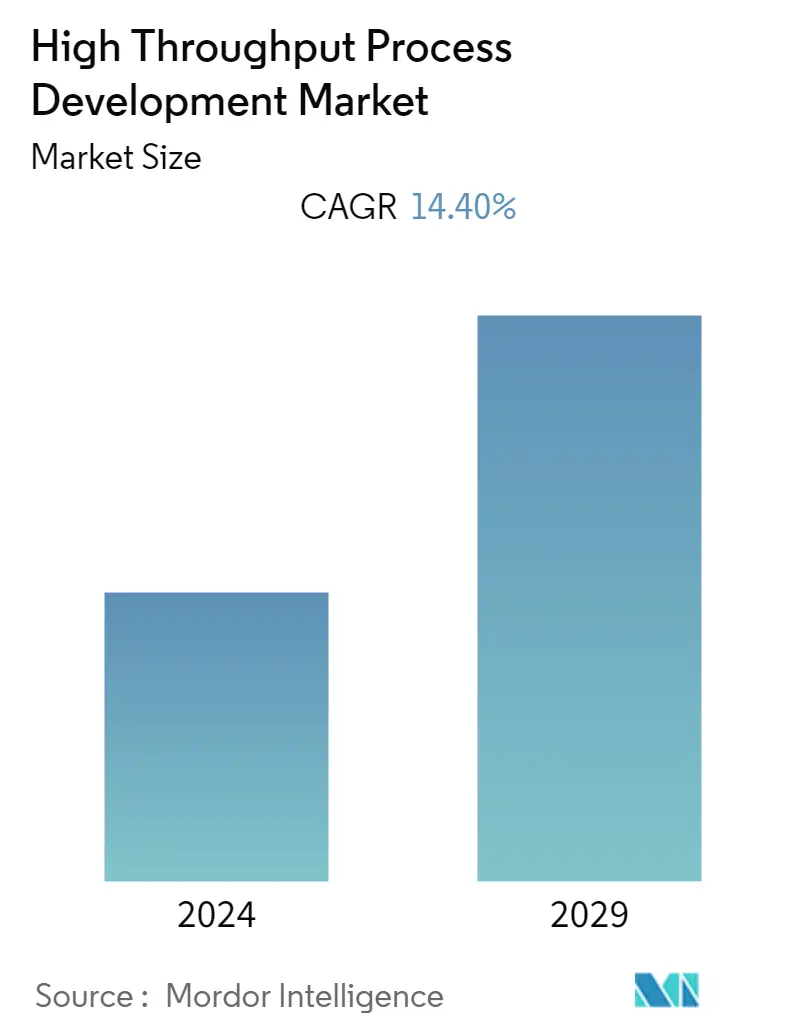Market Size of High Throughput Process Development Industry

| Study Period | 2018 - 2028 |
| Base Year For Estimation | 2021 |
| CAGR | 14.40 % |
| Fastest Growing Market | Asia-Pacific |
| Largest Market | North America |
| Market Concentration | Medium |
Major Players
*Disclaimer: Major Players sorted in no particular order |
Need a report that reflects how COVID-19 has impacted this market and its growth?
High Throughput Process Development Market Analysis
The high throughput process development market is expected to register a CAGR of 14.4% over the forecast period.
In its preliminary phase, the COVID-19 pandemic significantly impacted the high throughput process development (HTPD) market due to disruptions in research and development activities worldwide. As the pandemic continued worsening, it accelerated the vaccine and drug development process against the SARS-CoV-2 virus. As per the November 2022 update by BGI Genomics, an integrated solutions provider of precision medicine with the use of HTPD, upon the onset of the pandemic, the Institute of Molecular Genetic and Genetic Engineering (IMGGE) at the University of Belgrade immediately announced offering its expertise in molecular diagnostic methods. A partnership between BGI and IMGGE commenced with the construction of two permanent Huoyan laboratories. The first laboratory was established on the premises of the University Clinical Center of Serbia approximately 40 days after the pandemic was publicly disclosed. One of the two national laboratories for molecular diagnostics of infectious agents was established in Belgrade. By July 2020, the second National Laboratory, strategically positioned in the Serbian city of Nis to serve the region, was operational. Such developments contributed to the market's growth amid the pandemic.
In the post-pandemic phase, the market is expected to witness significant growth. For instance, as per the article published in September 2022 by Frontiers in Medical Technology, automated microfluidic technologies have considerable assurance for improving COVID-19 diagnostic test accessibility and speeding up high throughput detection techniques, specifically for POC testing. Additionally, COVID-19 diagnosis can easily be performed using the automated microfluidic platforms created for other pathogens. Thus, per the analysis, with the anticipated emergence of newer SARS-CoV-2 strains globally, the market is predicted to gain traction over the coming years.
Additionally, the growing need for identifying new drug targets, advancements in drug discovery and development technology, an increase in pharmaceutical research and development expenditure, and the benefits associated with HTPD in terms of cost reduction and process efficiency are major factors driving market growth in the coming years.
With high throughput screening, numerous samples can be examined simultaneously under the same circumstances. In addition, with robotic capabilities, hundreds and thousands of samples could be examined at once. The high throughput process development is speedier and more affordable for large sample sizes, making it a convenient option for screening newer drug targets for drug development. Such advantages offered by high throughput process development in the drug discovery process, where several potential drug candidates need to be screened, are expected to boost the market's growth shortly.
Moreover, a million human genomes were sequenced in 2020 due to high throughput sequencing technologies, revolutionizing genetics and genomics. As a result, the pharmaceutical industry now has access to a wide range of prospective therapeutic targets that demand additional investigation, driving the demand for high throughput process development.
Likewise, growing research and development in the pharmaceutical industry will contribute to the market's growth. For clinical trials of neurodegenerative diseases like Alzheimer's, drugs that target the central nervous system (CNS) have a historically high failure rate. Also, time consumption and costliness of in-vivo screening remain essential components of preclinical testing. High throughput technologies have recently made it possible for these tests better to meet the demands of the current pharmacological development pace. For instance, in June 2021, scientists from the University of Artois in France miniaturized a patented BBB in-vitro model, enabling automated high throughput compound screening. Robotic cell seeding, assay testing, and imaging were used to automate the model, which had previously been carried out manually using a 12-well format. Automation improved accuracy and decreased the time needed for assay execution by researchers. It significantly increased precision and reduced the time spent by researchers performing assays. Ultimately, this allowed more compounds to be screened in the early stages of drug discovery.
Furthermore, new product launches are contributing to the market's growth. For instance, in April 2021, Thermo Fisher Scientific received USFDA approval for high throughput and integrated COVID-19 Test Kit. Likewise, in November 2022, the FDA granted a EUA for Roche's COBAS MPXV high throughput test to detect mpox. Patients could immediately achieve the desired results with this high throughput solution in order to receive the right care as quickly as possible without being compelled to undergo needless additional testing or isolation. In December 2021, Becton, Dickinson, and Company's COR System was enhanced by adding a new MX instrument for high throughput molecular testing for infectious diseases.
Therefore, the studied market is expected to witness significant growth over the forecast period owing to the above-mentioned factors. However, the high cost of technology and the lack of infrastructure may impede the market's growth.
